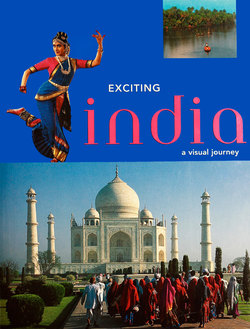Читать книгу Exciting India - Bikram Grewal - Страница 7
На сайте Литреса книга снята с продажи.
Оглавлениеa rich
historical record
Successive waves of settlers-sometimes bringing goods for trade, sometimes armies to conquer territory, and sometimes in search of land and peace-have left an indelible mark on the landscape and cultures of India.
Terracotta cart, Harappan civilization, c. 2700 BC. Sculpture depicting the Didarganj yakshi. Painting showing the tantric deity Tara, late 19th century.
tHE EARLIEST KNOWN INDIAN CIVILIZATION is that of the Indus Valley (c. 3rd millennium BC) centred on Harappa and Mohenjodaro, now in Pakistan. The Aryans from Central Asia were the first invaders: they spread through north India to Bengal, displacing the Dravidian inhabitants. The Aryan religion based on the Vedas was incorporated into Brahminism or early Hinduism. Alexander the Great invaded the Punjab in 327 BC, but the Greeks were driven out by Chandragupta of the Mauryan empire. Hinduism was the state religion until the reign of King Ashoka, who replaced it with Buddhism.
On Ashoka's death, the Mauryan empire disintegrated and northern India was then governed by a succession of dynasties until it succumbed to the Turks and Persians under Mahmud of Ghazni. These separate Muslim kingdoms were in turn subdued by Babur (1526), the founder of the Mughal empire. During the reign of Akbar (1556—1605), Mughal power was extended to most of northern and central India. Mughal architecture reached its peak under the rule of Shah Jahan (1627-58), but the empire disintegrated after the reign of Aurangzeb (1658-1707).
Stone Buddha head, Sarnath, 5th century. An ancient Hindu seal. Unicorn seal, Harappa civilization, c. 2700 BC. The ramparts of an ancient fort.
European interest in India began with Vasco da Gama's arrival (1498) at Calicut. During the 1600s, the British East India Company established trading posts at Surat, Bombay and Calcutta, driving off Portuguese and Dutch opposition. With the rapid decline of the Mughals, the British and the French extended their influence over the native states in the 18th century. This gave rise to Anglo-French conflict, which culminated in the expulsion of the French by the military victories of Clive. By 1850, the British Raj covered the whole of India.
Sword of Tipu Sultan, Srirangapatnam, AD 1795.
Detail of marble inlay work on the sandstone gateway of Akbar's tomb at Sikandra, Agra.
Gold coin of Mughal emperor Shahjahan.
Illustrated folio of the Baburnama, depicting a royal hunt. The manuscript chronicles the life and times of the first Mughal emperor, Babur.
The still waters of a river reflect the fort built on its bank.
Early missionaries from Portugal came by sea to Goa on the western coast of India.
A view of the Rashtrapati Bhavan in New Delhi, built in Indo-Saracenic style by Corbusier and Baker.
tHE INDIAN DESIRE for self-government led to the formation of the Indian National Congress (1885), and after the First World War, Mahatma Gandhi led a national movement of passive resistance against British rule that finally brought independence to India. Soon thereafter, on August 17, 1947, the subcontinent was partitioned between India and Pakistan.
A decorative element of the Victoria Memorial in Calcutta, conceived by Lord Curzon as a monument to Queen Victoria.
'Court House Street', Calcutta, a painting by James Baillie Fraser.
The camel-borne Border Security Force of India at Beating Retreat, a ceremony that celebrates the significance of the armed forces in the Republic of India.
